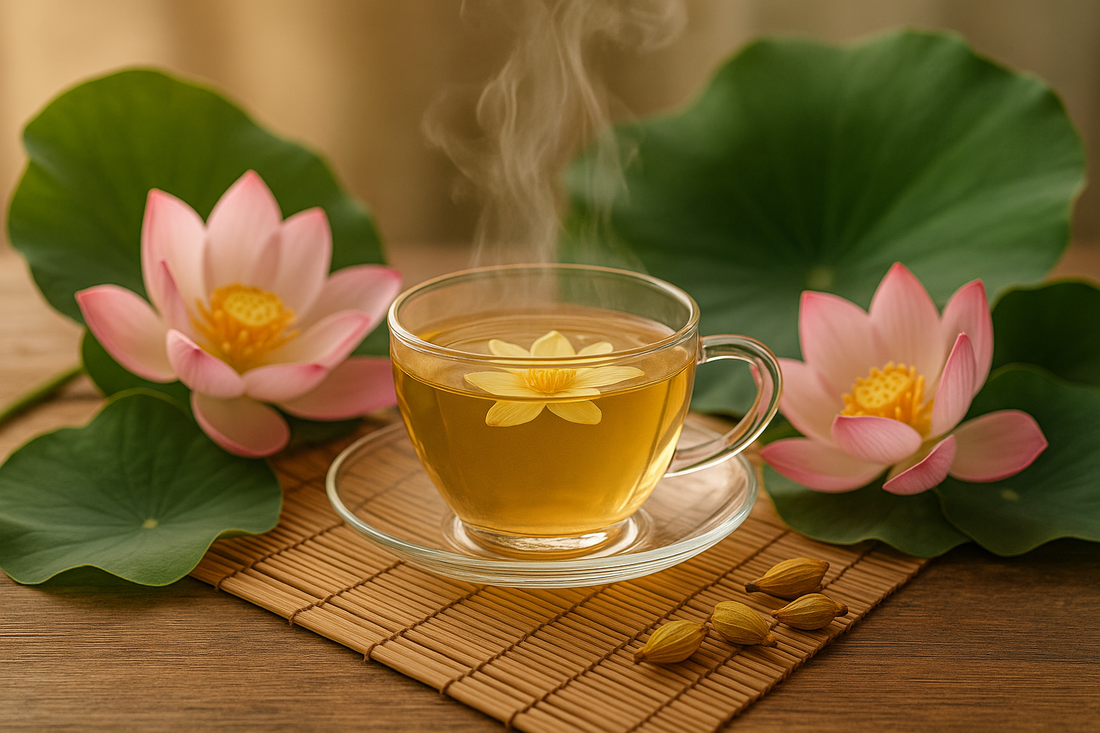
Lotus Tea: The Hidden Art and Ancient Alchemy of Scented Tea
Share
Lotus Tea is one of the most mesmerizing and labor-intensive treasures of the tea world. More than just a beverage, it represents a perfect harmony of human artistry and natural fragrance — a craft that has survived centuries in Southeast Asia.
But beyond its poetic charm, users and tea lovers today are asking: Does it really work? What does it taste like? Is it worth the price?
Let’s uncover the craftsmanship, meaning, and sensory depth behind this cultural icon — and how it connects to broader traditions of comfort meals and healing balance found across Asia.
What Is Lotus Tea?
Lotus Tea is not a flavored tea made with oils or extracts. Instead, it’s a naturally scented tea, where green or dark tea leaves absorb the pure aroma of lotus flowers through an ancient, time-sensitive process.
In Vietnam — especially around Hanoi’s lotus-filled lakes — artisans have elevated this tradition to an art form, making it one of the country’s most iconic cultural products.
Unlike most floral teas, lotus tea doesn’t just smell floral — its fragrance becomes part of the leaf’s soul. Each sip carries a depth that is calming, earthy, and gently sweet, echoing the balance of nature itself — much like the harmony between body and mind explored in comfort meals and healing balance.
The Meticulous Craftsmanship Behind Lotus Tea
Creating true lotus tea is a race against time and temperature — a form of living alchemy. The process is so demanding that high-quality lotus tea is considered a luxury product.
1. Harvesting the Flowers at Dawn
Lotus buds are hand-picked before sunrise, just as they begin to bloom. At dawn, their aroma compounds are at their peak concentration. Once sunlight hits, the volatile oils quickly evaporate — meaning every minute counts.
Reddit tea enthusiasts often marvel at how precise this process is, comparing it to the way fine perfume houses harvest flowers for essential oils.
2. The Sacred Scenting Process
This is the soul of lotus tea.
There are two main artisanal techniques:
- The Traditional Way: Tea leaves are carefully placed inside freshly picked lotus buds, then tied and left overnight. During those 24 hours, the leaves naturally absorb the flower’s fragrance.
- The Layering Method: Artisans layer tea leaves with lotus petals and stamens (the pollen-rich parts), sealing them in a container to capture the most intense aroma.
The highest grades repeat this process up to three times using new flowers each day — a breathtakingly laborious task that multiplies the tea’s depth and cost.
3. Drying and Preservation
Once the tea has fully absorbed the lotus essence, it is gently dried at low temperatures to preserve its fragrance. This ensures that the aroma blooms only when steeped — not lost to the air.
The Base Tea: Green or Dark?
The choice of base tea determines how the lotus aroma unfolds:
- Green Tea Base: Traditionally used for its fresh, grassy sweetness. It produces a bright, floral, and calming brew that feels almost spiritual.
- Dark Tea (Hei Cha) Base: A modern innovation. It adds depth — earthy, woody, and subtly sweet — creating a more grounded, meditative experience.
Both types bring out different personalities of the lotus: one airy and ethereal, the other warm and contemplative.
The Flavor Experience (and Why Reddit Is Divided)
Reddit discussions about lotus tea often focus on flavor confusion. Many first-time drinkers expect a sweet floral note but are surprised by a mildly bitter, earthy taste.
This variation depends on the tea base, freshness of the flower, and how it’s brewed. For instance:
-
Over-steeping or using boiling water can make the tea taste overly bitter.
-
Discarding the first steep — as many Reddit users suggest — helps reduce harshness and brings out a softer floral finish.
The ideal lotus tea should taste balanced — floral, vegetal, and lightly honeyed — not perfumed or synthetic.
Symbolism: More Than a Drink
Across Asia, the lotus flower symbolizes purity, rebirth, and enlightenment, as it rises clean from muddy water.
To drink lotus tea is to sip this philosophy — a sensory meditation connecting craftsmanship, patience, and inner balance.
That’s why many tea practitioners describe lotus tea as “a cup of calm” rather than just another herbal infusion.
How to Brew Lotus Tea (for the Best Aroma)
- Water temperature: 80–85°C (175–185°F)
- Steep time: 2–3 minutes for green-based tea, up to 5 minutes for dark tea
- Portion: 3–4 grams per 200ml water
- Discard the first infusion if the tea tastes bitter — it helps reveal the hidden sweetness.
- Try cold brewing overnight for a lighter, refreshing aroma.
FAQs About Lotus Tea
1. Does lotus tea really help with sleep or dreams?
Some Reddit users report vivid dreams or better sleep after drinking it, especially blue lotus tea. However, scientific evidence is limited. The relaxation likely comes from mild sedative compounds and the ritual itself.
2. Why does my lotus tea taste bitter?
It may be over-steeped or made with very mature leaves. Use cooler water (around 80°C) and reduce brew time.
3. Is lotus tea caffeine-free?
If it’s made from lotus leaf or flower only, it’s caffeine-free. But if it’s scented green tea, it will contain caffeine.
4. What’s the difference between lotus leaf tea and lotus flower tea?
Lotus leaf tea is herbal and used for detox or digestion. Lotus flower tea is scented and valued for aroma and relaxation.
5. Where can I find authentic lotus tea?
Look for Vietnamese brands (Hanoi origin) or artisanal producers who describe their scenting process. Avoid overly “perfumed” teas, which often use artificial fragrance oils.
Lotus tea is not just about taste — it’s about time, precision, and patience. Every cup holds the sunrise, the fragrance of still water, and centuries of craftsmanship.
Whether you drink it for beauty, calm, or curiosity, this tea remains one of Asia’s most poetic gifts to the world.
